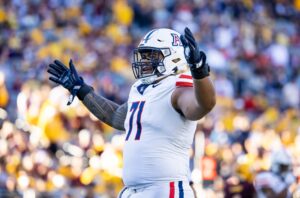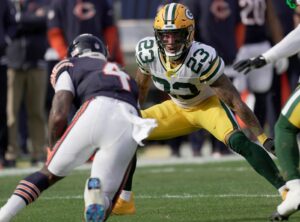Alan Faneca is one of the finalists for the Hall of Fame this season, and based on what he accomplished in his career, he deserves to be elected this season.
Alan Faneca for the Hall of Fame
Guards Tend to be Undervalued
Guard is one of the least glamorous positions in football, but absolutely essential to allowing an offense to be as dynamic as possible. Tackles are valued as the watchdogs of high-priced quarterbacks in pass protection against ferocious edge rushers, and guards are often thought of as less of a priority in the construction of a great offensive line. This is evident when talent evaluators are wary of selecting guards too high in the draft, or when executives shy away from committing too much money to guards.
The belief is that great guards are easier to find than great tackles, and perhaps there is some truth to this given the demands and prerequisite skills involved in playing each position. However, when guards fall victim to this type of severe devaluation, it’s harder for truly transcendent guards to be properly appreciated amongst the legends of the game.
Faneca has been eligible for four years now, and he has also been a finalist for the Hall of Fame in each of his seasons eligible. Faneca is extremely qualified to be enshrined, and given his credentials, it’s amazing that it has taken him so long to get in. Guards aren’t glamorous, but beyond their roles in pass protection, they’re the ones who open up holes for the running game to exploit, and Faneca was a transcendent talent at the position.
Faneca Has Amazing Credentials
Faneca is one of the best run-blockers to ever play in this league, and there have been very few guards more worthy of induction than him. The only players in NFL history who have made more AP All-Pro First Teams during a career playing primarily at guard are John Hannah, Bruce Matthews, and Randall McDaniel. Faneca not only belongs in the Hall of Fame eventually but based on his dominance at his position for so long, he deserves to be in the class of 2019.
Faneca spent the first 10 seasons of his career with the Pittsburgh Steelers beginning in 1998, the next two seasons with the New York Jets and retired after spending the 2010 season with the Arizona Cardinals.
During his career, he made the AP All-Pro First Team six times and was selected to the Pro Bowl nine consecutive seasons from 2001-2009. He was named to the NFL 2000s All-Decade First Team at guard and was also named to the Steelers All-Time Team in 2007.
Faneca was originally selected in the second round of the 1998 NFL Draft by the Pittsburgh Steelers, and won the Joe Greene Award as the team’s top rookie that season. He soon became a stalwart at left guard and would anchor a unit that consistently produced strong rushing offenses. Demonstrating his versatility, he actually became the team’s starting left tackle in 2003 due to injuries to their offensive line. When the Steelers won the Super Bowl after the 2005 season, he helped Willie Parker set a Super Bowl record with a 75-yard run in that game.
During the 2008 off-season, Faneca signed the richest contract ever given out to an offensive lineman when he joined the New York Jets via free agency. He made two Pro Bowls with the Jets before being released following the 2009 season, and they are the only franchise he made a Pro Bowl with every season he played for them. Faneca didn’t make the Pro Bowl until his fourth season with the Steelers, although he made it in each of his last seven seasons with them. He signed with the Arizona Cardinals for the 2010 season and started all 16 games for them before announcing his retirement.
Faneca absolutely deserves induction to the Hall of Fame, and really needs to be one of the five who gets selected in this class. Given what he accomplished during his career, it’s amazing that it has taken him this long to earn enshrinement to the Hall of Fame. He started every game in the last nine seasons of his career and played in 206 out of 208 games during his 13-year career. His toughness and durability were remarkable, and he anchored offensive lines for some really impressive teams, including the 2005 Super Bowl winning Steelers.
Faneca would be representing the Steelers if elected, and he would become the 22nd player in the Hall of Fame who spent a significant portion of their career with the Steelers. There are currently 18 guards in the Hall of Fame, and Faneca deserves to be the next one who joins that illustrious group of players.
2019 Finalists Are an Impressive Group
There are 15 finalists for the 2019 Hall of Fame, and that group will be narrowed to 10 and then to five possible inductees. Those final five players will be individually voted upon, and each must secure at least 80 percent of the vote from members who have a vote. The class of 2019 will be announced on February 2.
The early buzz is being generated by three players who are eligible for the first time in this group: Tony Gonzalez, Ed Reed, and Champ Bailey. All three have had such prolific careers and achieved so many accolades that there’s an extremely strong case to be made that they all deserve to go in on the first ballot.
If Gonzalez, Reed, and Bailey instantly jump to the front of the pack, there are two more spots left for the 12 other candidates this season. Besides Faneca, the other finalists are Steve Atwater, Tony Boselli, Isaac Bruce, Steve Hutchinson, Edgerrin James, Ty Law, John Lynch, Kevin Mawae, Richard Seymour, and head coaches Don Coryell and Tom Flores.
Each of the 15 finalists this season is worthy of the Hall of Fame based on their achievements, but when only five can get in this year, it becomes necessary to prioritize certain inductions above those of others.
Neither Coaches Deserve to be Elected this Year
When examining the resumes of the two coaches nominated, while both are certainly qualified for induction, neither one jumps out as needing immediate enshrinement before any of the 13 players they’re up against.
Coryell never got to any Super Bowls but revolutionized the type of vertical offense a team routinely utilizes in the contemporary NFL. His strongest case is based on pioneering an offensive style, but it’s difficult for any coach to gain significant traction without at least one championship. Coryell has a lower career winning percentage than guys like Mike Holmgren, Bill Cowher, and George Seifert, all of whom have a Super Bowl win (Seifert has two) and none of which are in the Hall of Fame.
Flores is one of only 13 coaches who has won at least two Super Bowls, but of those 13 coaches, he has the lowest career winning percentage in the regular season. Mike Shanahan has two Super Bowls as well, plus has a higher winning percentage than Flores and just a slightly lower ratio of seasons in which he made the playoffs compared to total seasons coaching. Shanahan isn’t in the Hall of Fame, and given how comparable his coaching stats are to Flores, there’s not an overwhelmingly powerful sense that Flores needs to be inducted immediately.
Seifert probably deserves induction before both Flores and Coryell based on his superior winning percentage and multiple championships. The perception is that Seifert coasted off of a dynasty built by Bill Walsh, but Seifert had a higher win percentage in the regular season and the same number of playoff wins as Walsh.
With guys like Seifert, Holmgren, Shanahan, and Cowher not yet in the Hall of Fame, Flores and Coryell don’t stand out as figures who should necessarily jump to the front of the line. Without needing a spot for either of the coaches, that leaves the five spots available for the 13 players.
Assessing the 13 Player Finalists
The different positions out on the field have such varied roles, and it’s challenging to quantify how much more important an elite player in one position is compared to one at another position.
All-Pro appearances are a really good indicator of where a player stands relative to other players tasked with the same role. There are multiple organizations that name All-Pro teams, but generally the most prestigious tends to be the one from the Associated Press. Pro Bowls are slightly less prestigious, but still a really good indicator of not only a player’s talent but also their popularity and general impact on the football landscape.
In terms of AP All-Pro First Team selections amongst this group of 13 players, the leaders are Faneca and Gonzalez with six, Reed and Hutchinson with five, and Bailey, Boselli, Mawae, and Seymour with three. In terms of Pro Bowl selections, the leaders are Gonzalez with 14, Bailey with 12, and Faneca, Reed, and Lynch all with nine.
Out of all these players, Gonzalez really seems like the guy who is the most deserving of going into the Hall of Fame this year. Faneca is tied for the most AP All-Pro First Team selections amongst this group and tied for third in total Pro Bowl appearances. If Gonzalez is the main guy in this class, Faneca should be the second guy most worthy of induction for this year.
Bailey should be ahead of players like Boselli, Mawae, and Seymour due to his lofty number of Pro Bowl appearances compared to those other guys. Bailey is the third most deserving guy to be elected within this class, especially with all those Pro Bowl appearances and his lengthy run as such a feared cornerback.
Reed should be the fourth most deserving of induction this year, as he spent so much of his career as arguably the most intimidating ball hawk in the league. Reed and Lynch were both safeties with nine Pro Bowl appearances, but Reed has more AP All-Pro First Team spots.
Hutchinson deserves that fifth spot because he has that blend of not only dominance but also longevity as one of the premier offensive linemen in football. Hutchinson was the other guard alongside Faneca who was named to the NFL 2000s All-Decade First Team, and both were always locks for the All-Pro spots at guard.
Those top five guys are really the upper echelon of players in a group of finalists that feature so many football legends. Lynch has a lot of Pro Bowl appearances under his belt, but a relative lack of AP All-Pro First Team appearances hurts his chances of being worthy of induction this season. Lynch had just two AP All-Pro First Teams during his career, which doesn’t really assert him above some other finalists.
The lack of longevity is what really hurts Boselli the most. The three AP All-Pro First Team selections and five Pro Bowls are certainly impressive, but he only played in seven seasons before having to retire due to injury. The ratio of AP All-Pro First Team selections to actual seasons in the league is impressive for Boselli, but it’s really not long enough of a career to catapult Boselli over some of these other finalists.
At their respective peaks, Mawae probably wasn’t quite as dominant as Boselli as an offensive lineman. However, Mawae can boast such a degree of durability that Boselli simply didn’t have. In the 16 seasons Mawae spent as a center in the NFL, he played in all 16 games in 12 seasons, and at least 14 games in 15 of the seasons.
What hurts Atwater most is that he didn’t play into his mid-to-late 30s, so he doesn’t have some of those extra years towards the end to significantly elevate himself over a guy like Lynch. Seymour is the same way, and it makes it more difficult to advocate for other guys who continued collecting accolades at the end of careers that were longer. These are all great players, and details like that are what end up making the difference when tough choices need to be made.
With guys like Law, James, and Bruce, their cases really rest more on production levels at their respective positions to justify being in the Hall of Fame than lofty All-Pro or Pro Bowl appearances. When only five players can get in at a time, it’s difficult to justify certain players gaining entry over others that have far more honors like those distinctions.
What helps Law the most is that he has more career interceptions than Bailey, and he led the league in that category in two of his 15 seasons. Of the 22 players that have as much or more interceptions than Law and have been eligible for the Hall of Fame before this year, 13 have made the Hall of Fame. He certainly deserves induction at some point but is likely going to have to wait while guys with more renown get in ahead of him.
While James doesn’t deserve to get in this year, he certainly has a strong case that he needs to eventually to be inducted when compared to other guys at his position who have already been inducted. James is 13th all-time in rushing yards, and all 14 running backs in the top 16 of that category who are eligible for the Hall of Fame have made it. Given that he also has more total touchdowns in his career than legendary running backs like Tony Dorsett and Thurman Thomas, James definitely deserves to be in the Hall of Fame.
Bruce is in a similar situation as James, seemingly the next in line at his position to be inducted as of now, but a bit behind the other finalists this year. Every wide receiver who has been eligible for the Hall of Fame with more catches, yards, or touchdowns has been inducted. It’s unclear how long Bruce will have to wait, but based on precedent with how wide receivers have been inducted, Bruce definitely belongs in the Hall of Fame.
Each Finalist is Worthy of Eventual Election
All 15 of these finalists are absolute legends of the game. Hopefully, they all get elected to the Hall of Fame at some point. Based on what they accomplished in this league, every person in this group of finalists needs to be inducted eventually.
All things considered, though, it seems like the best five choices for induction this season are Gonzalez, Faneca, Bailey, Reed, and Hutchinson. All the finalists are deserving of eventual induction, but those five are the ones that need to go in before the other finalists they’re up against.






